
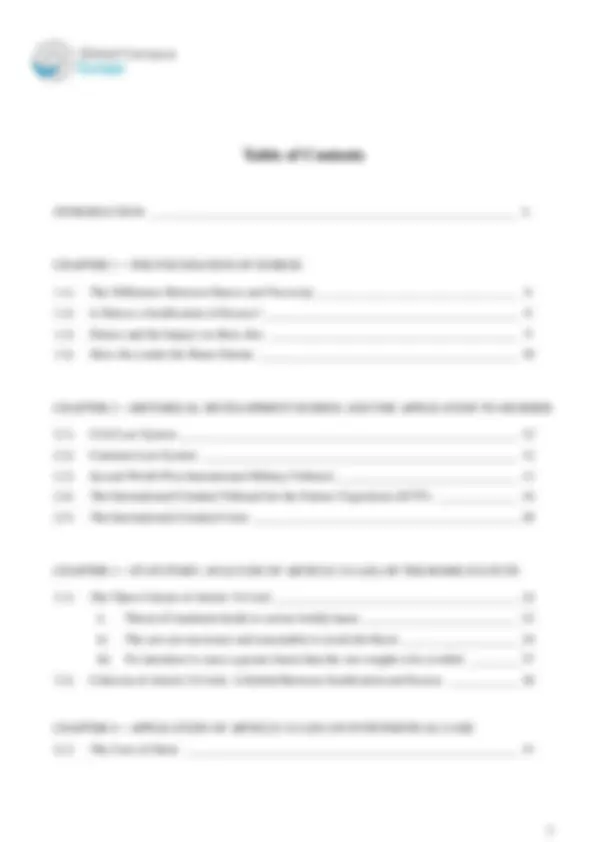

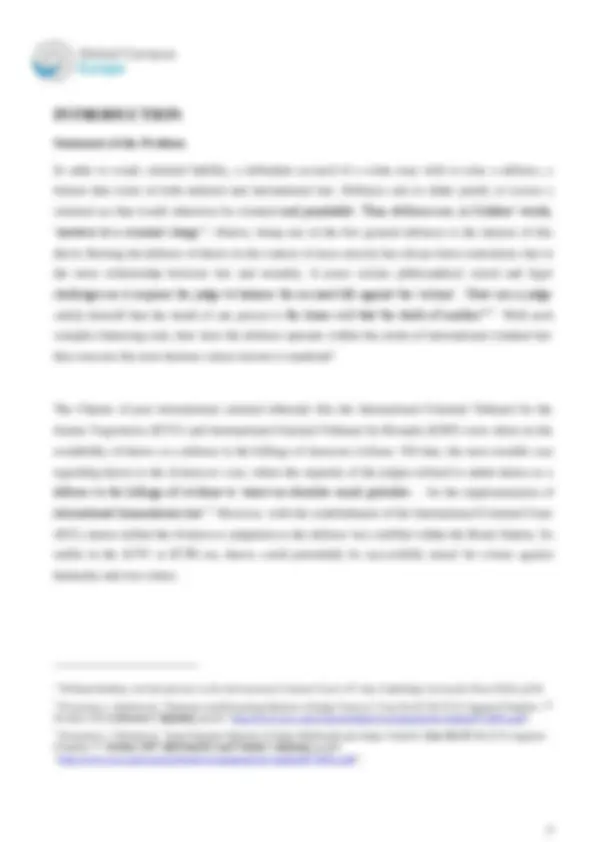
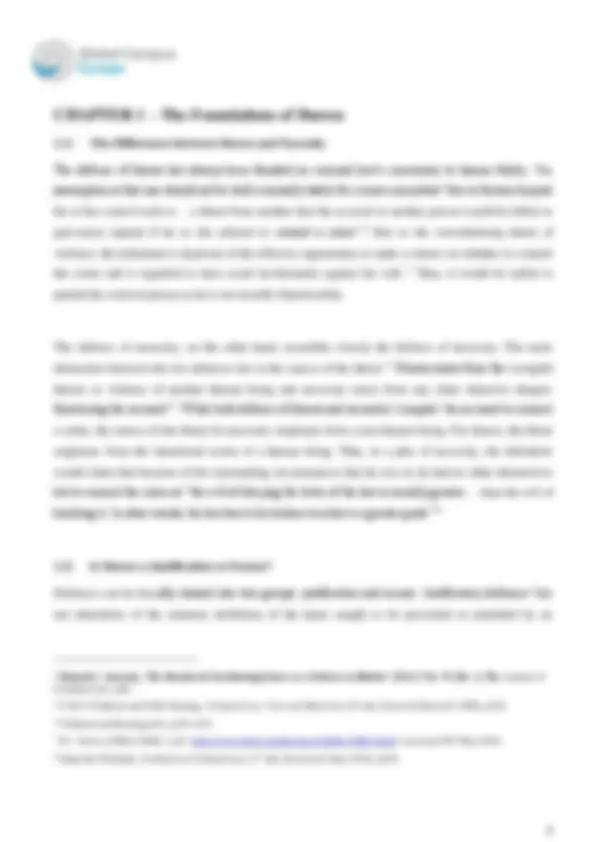
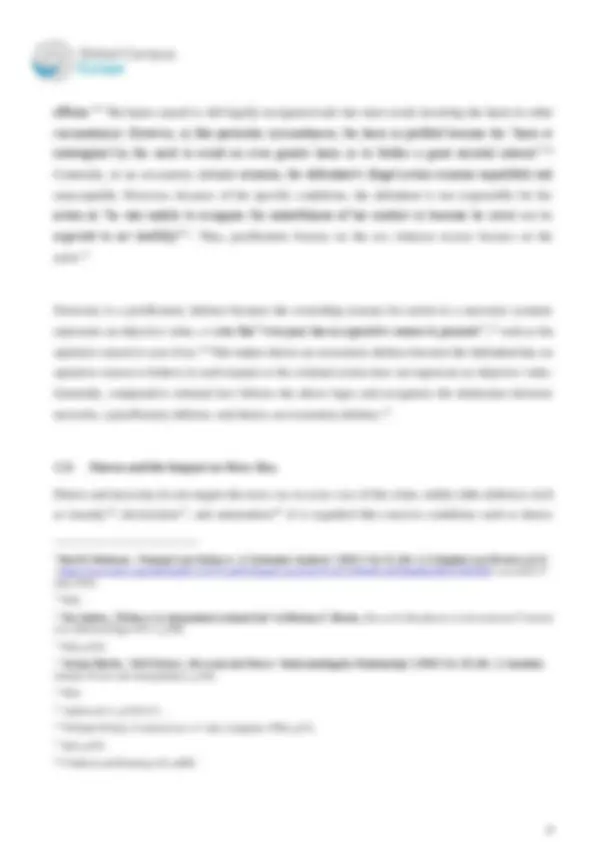
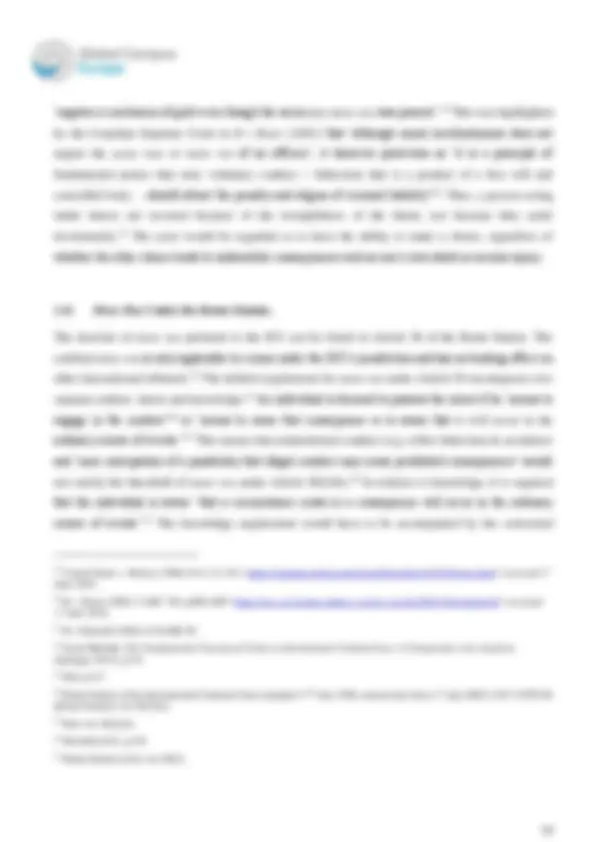
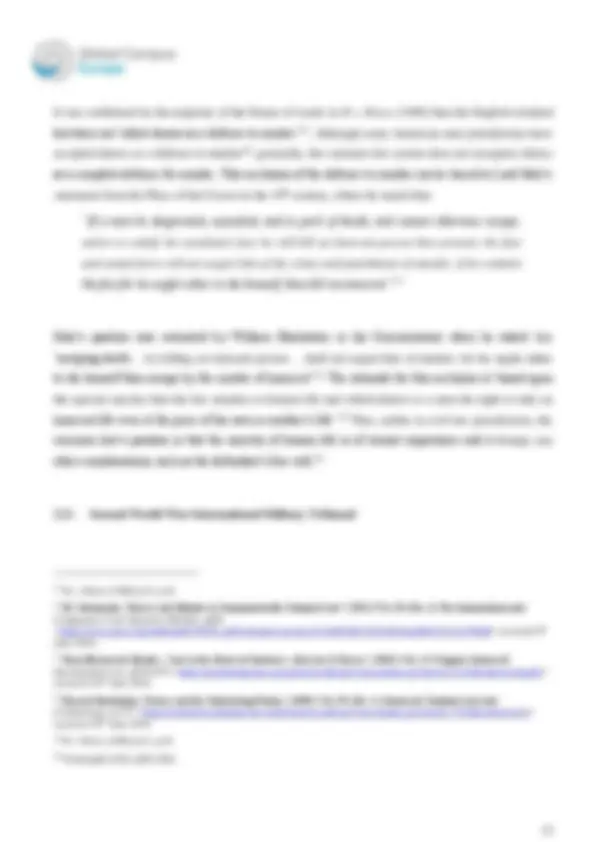
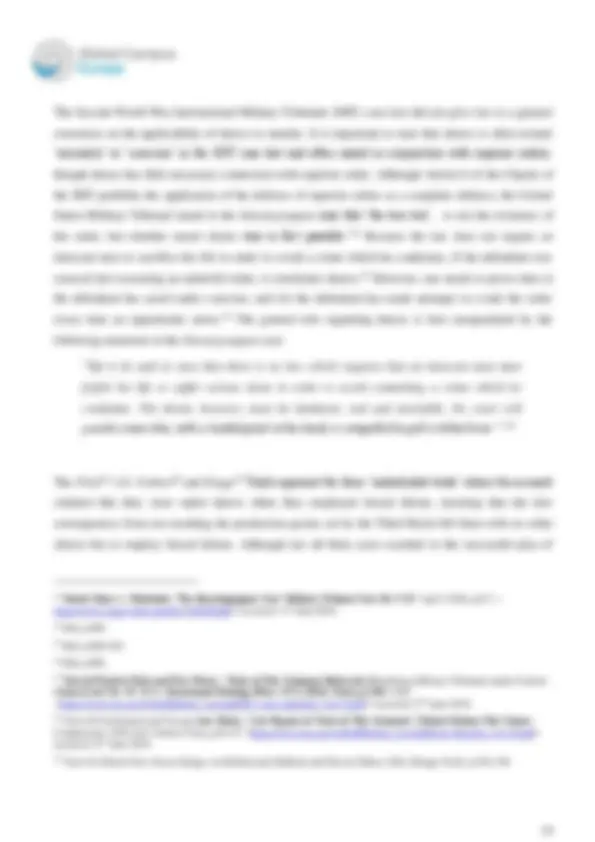
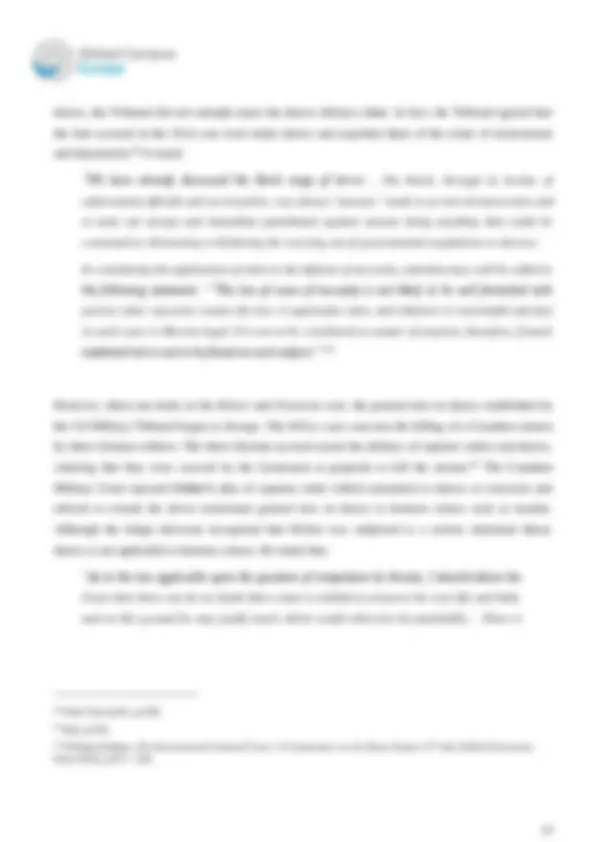
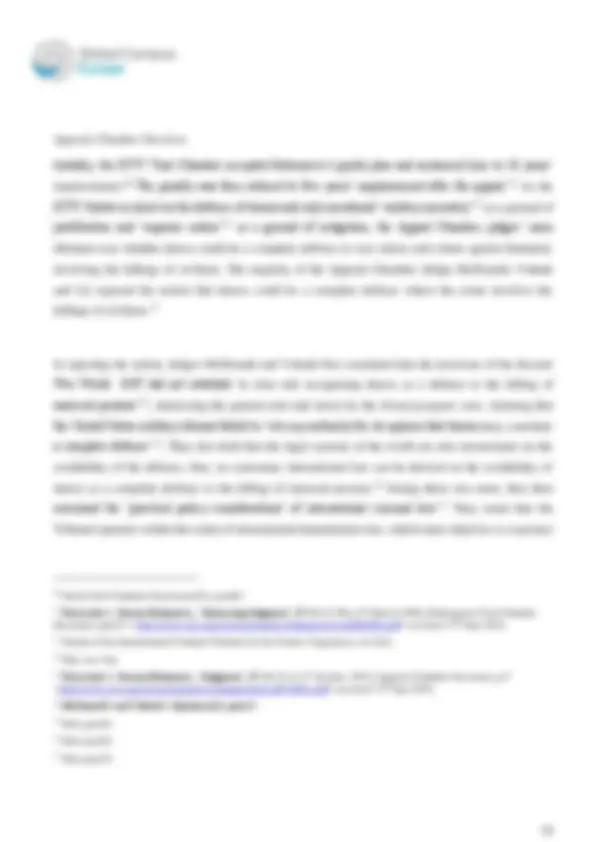
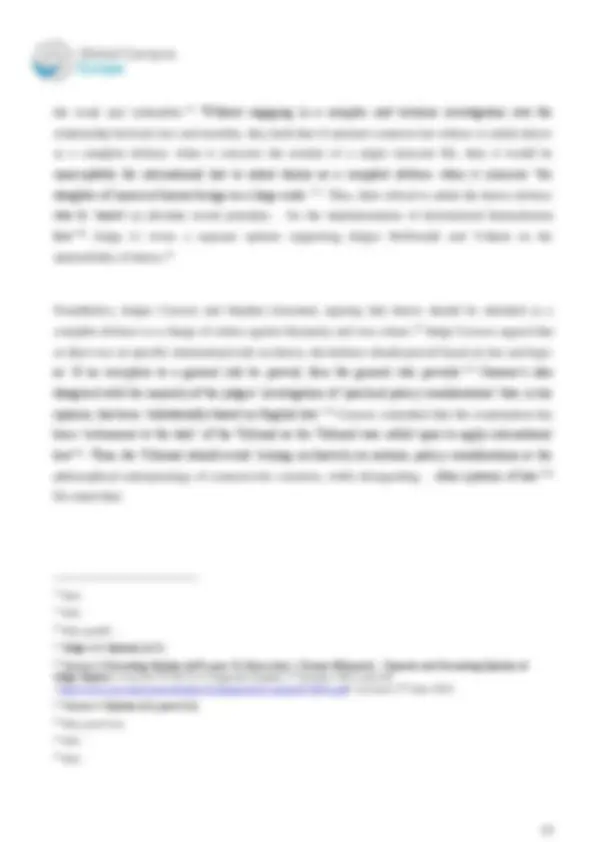
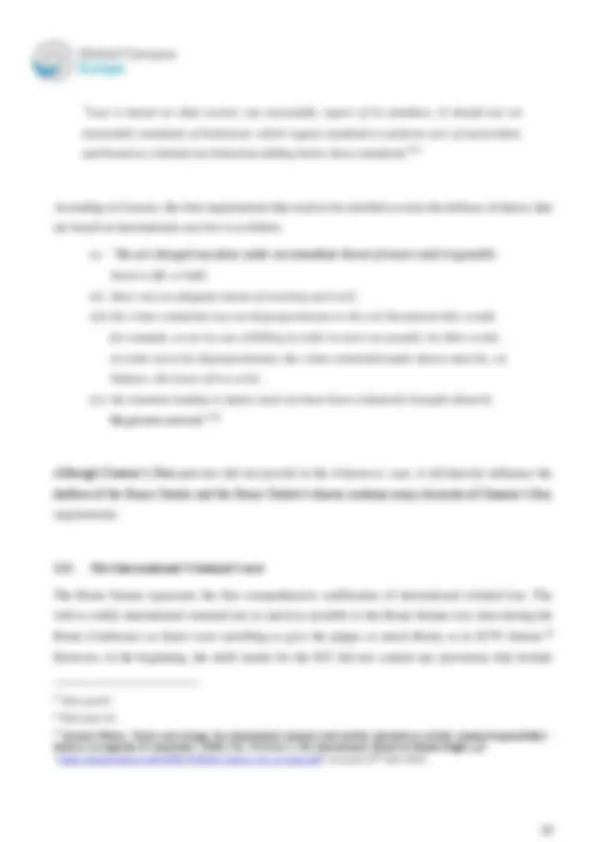
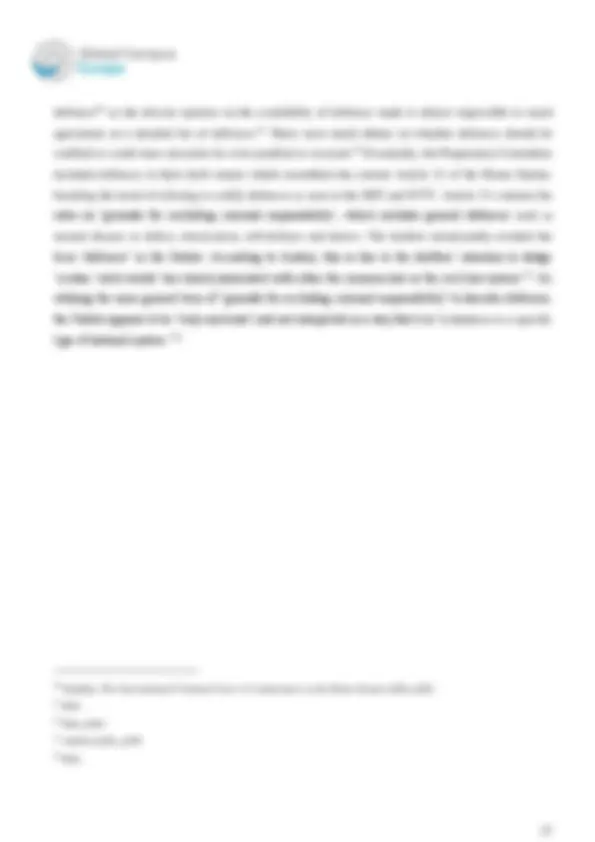
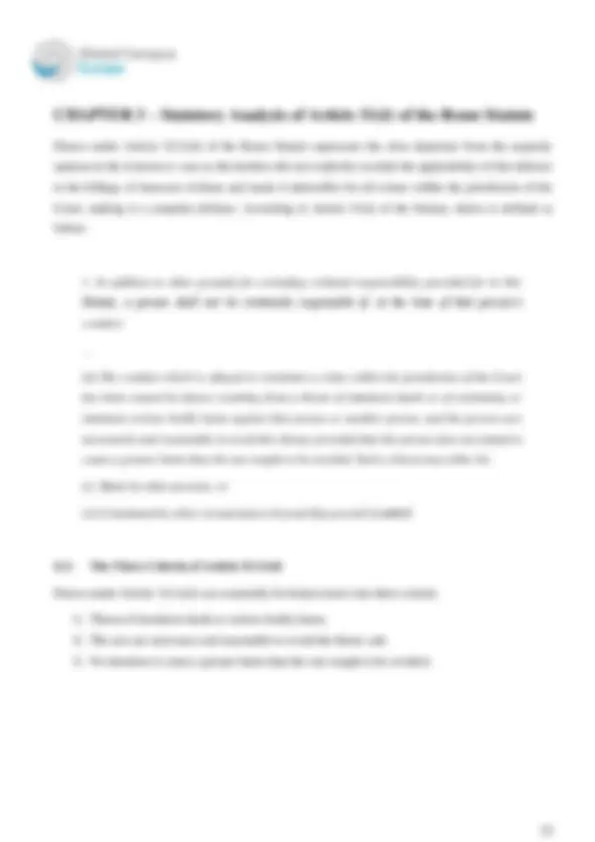
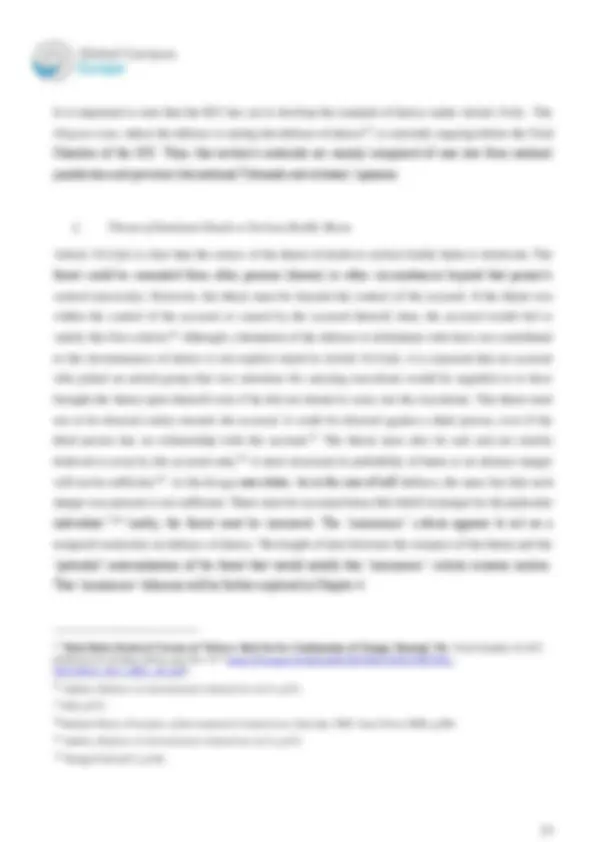
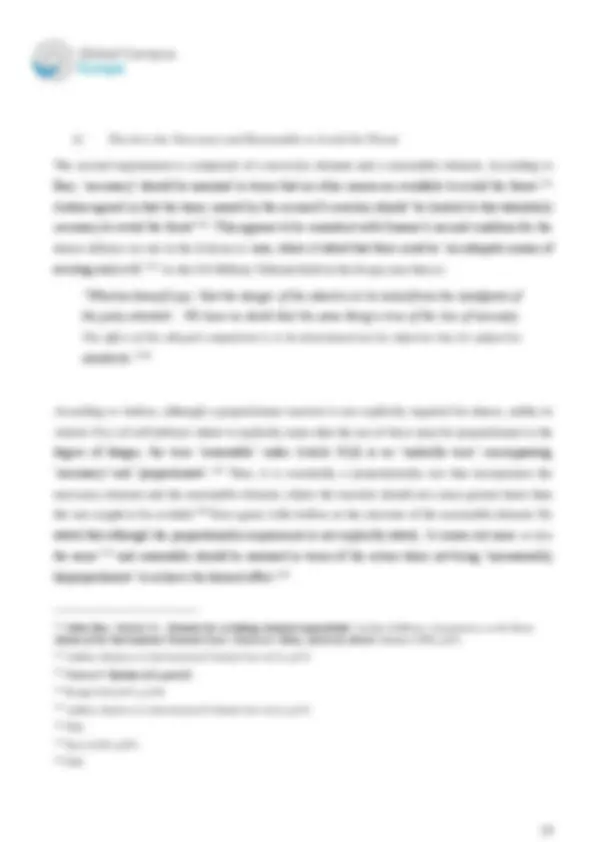
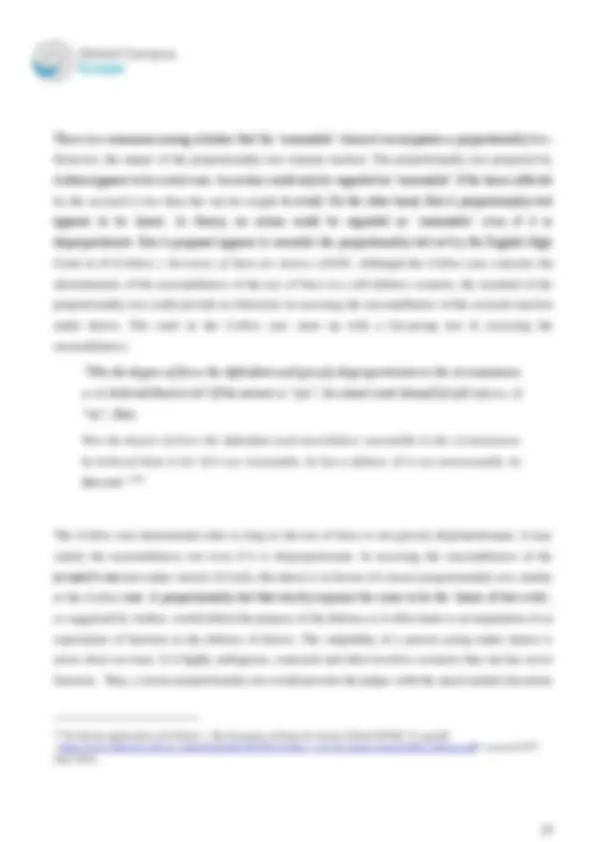
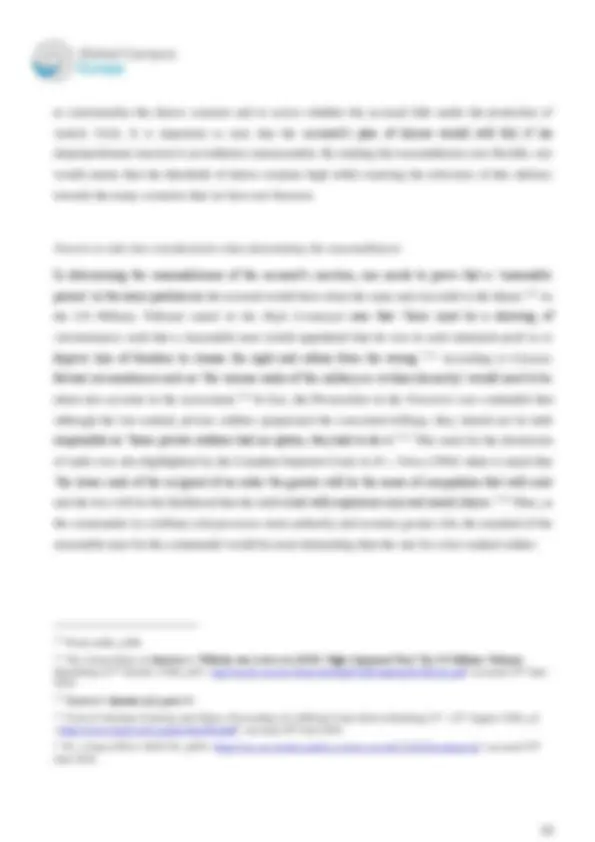
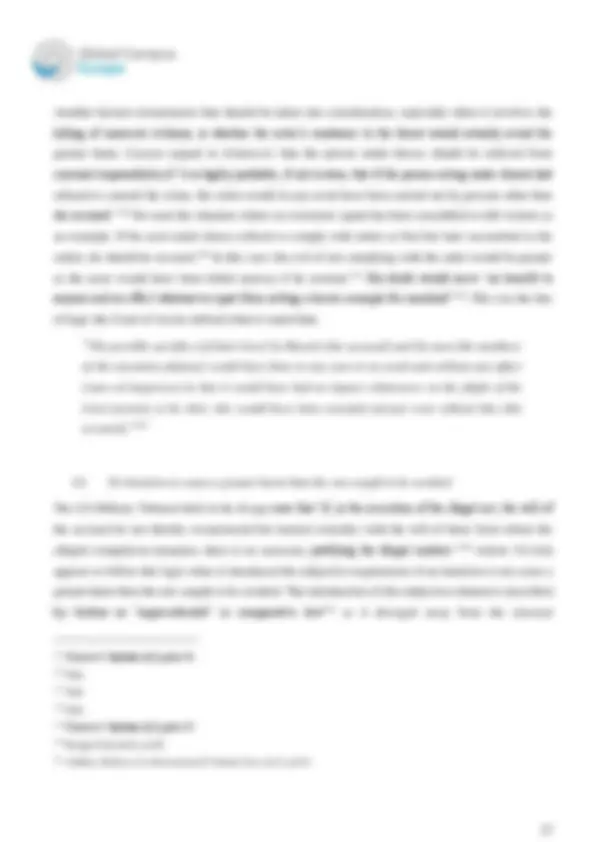

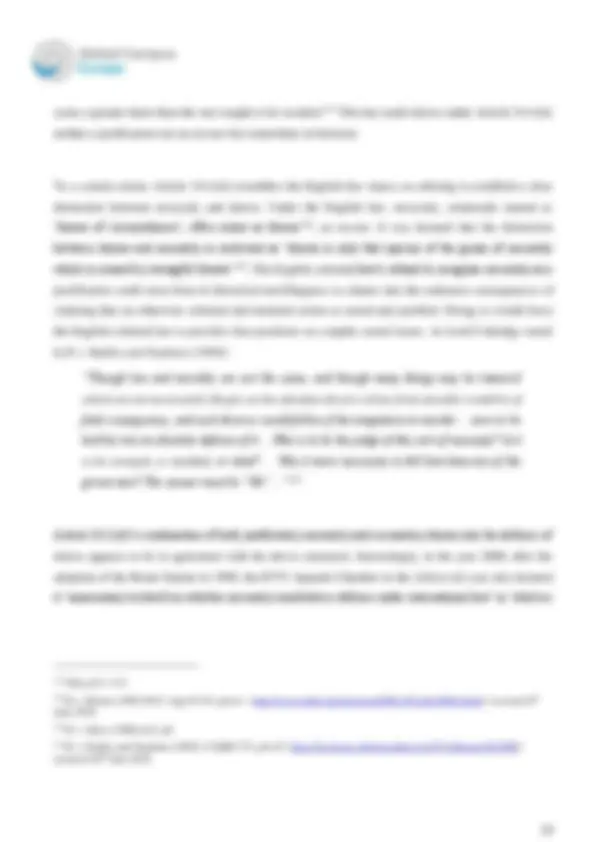

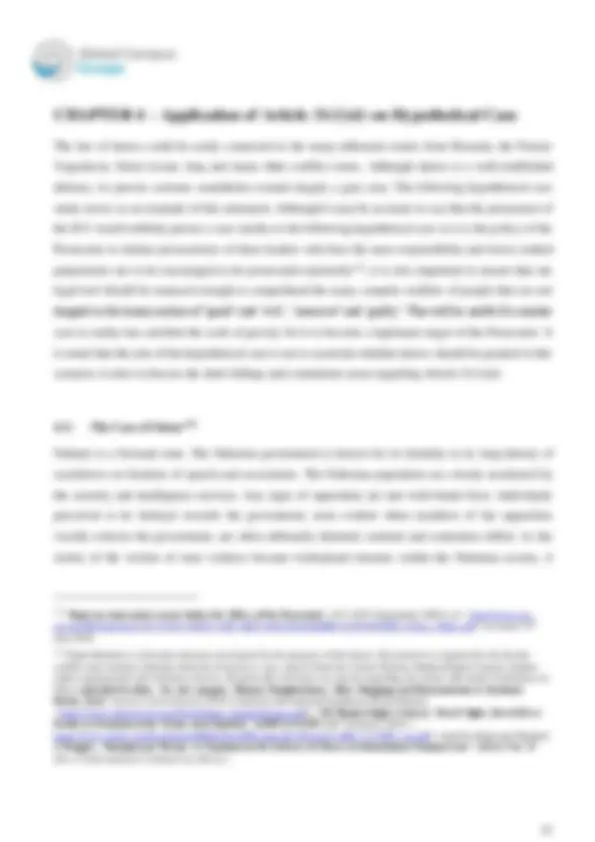
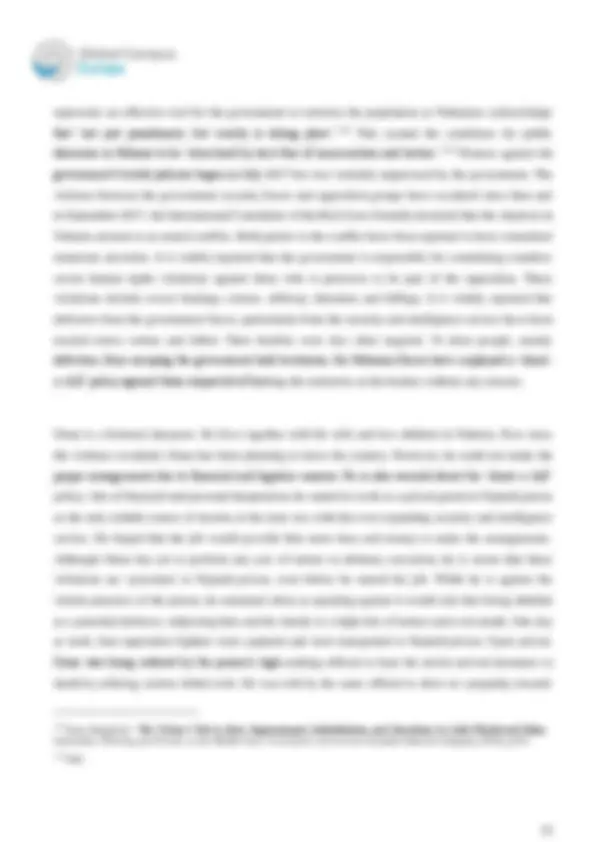
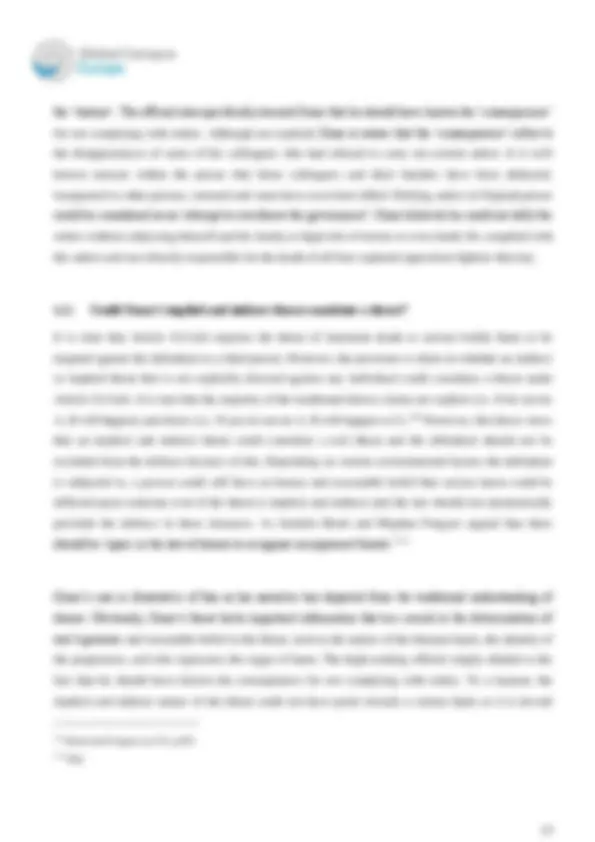
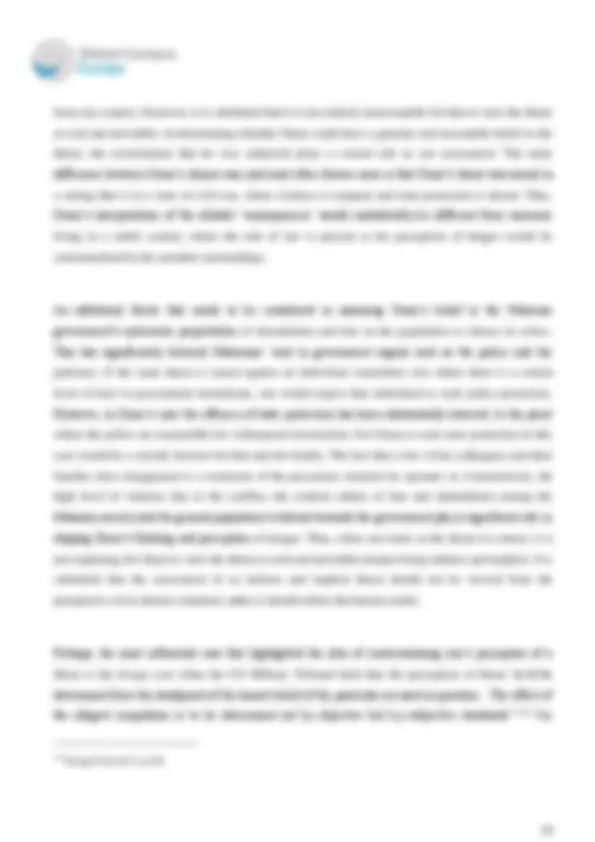
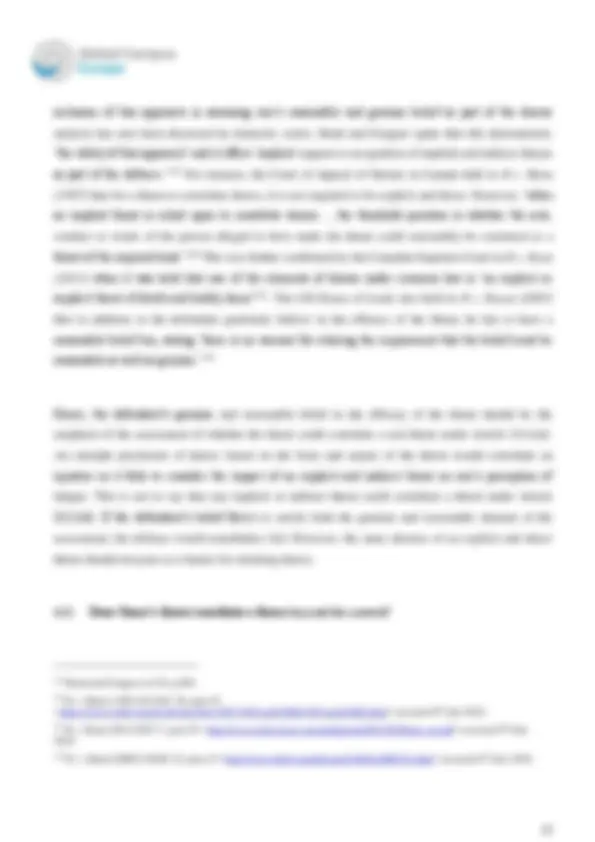
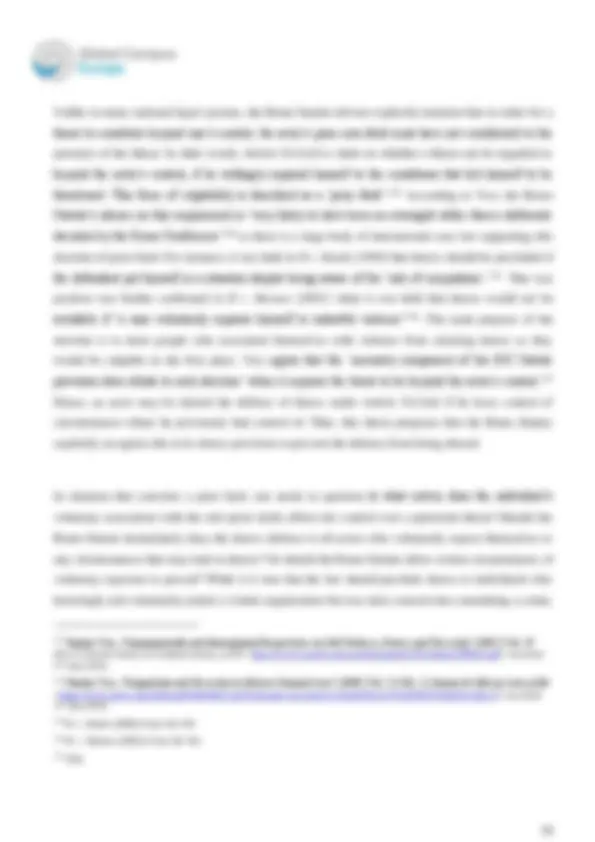
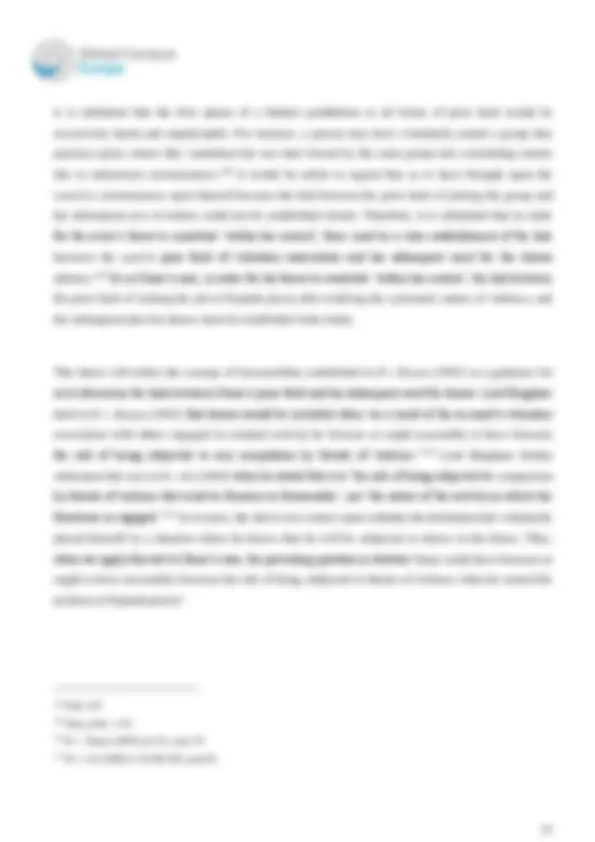
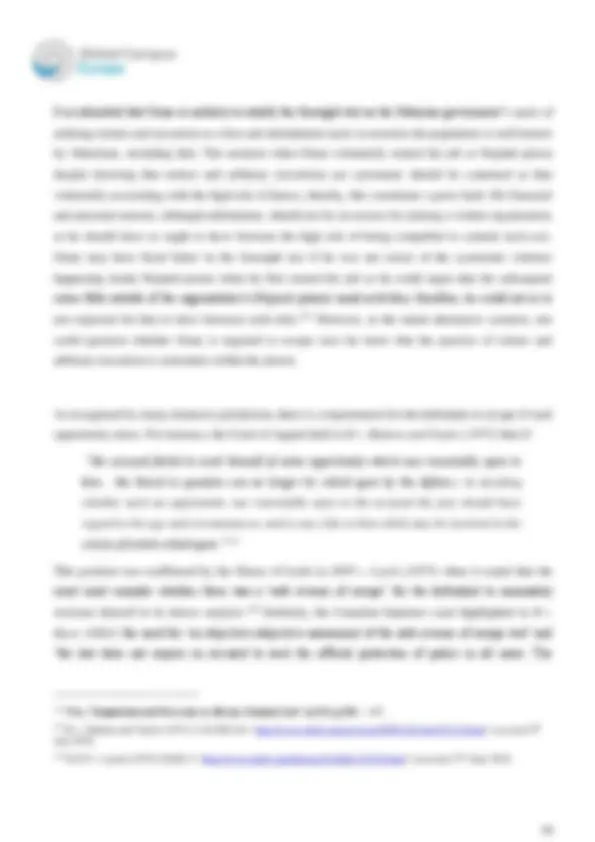
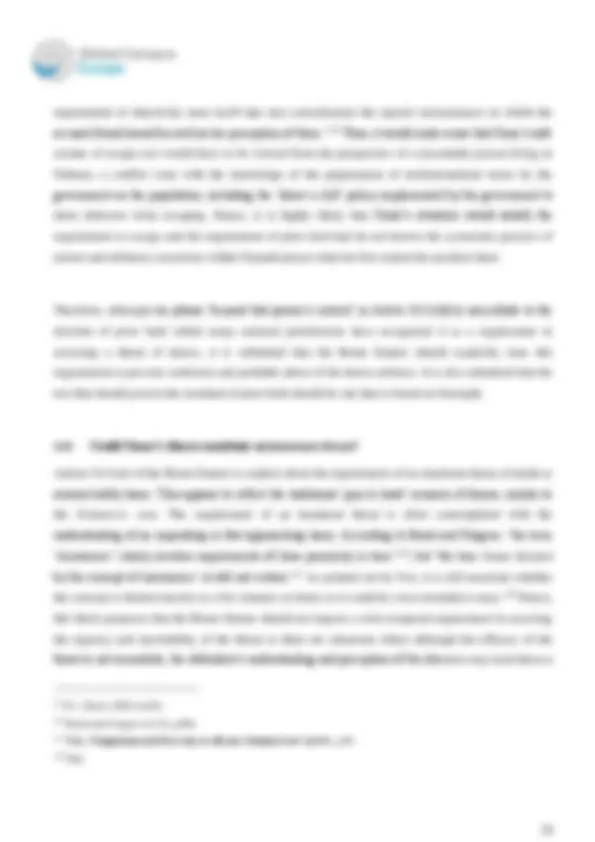
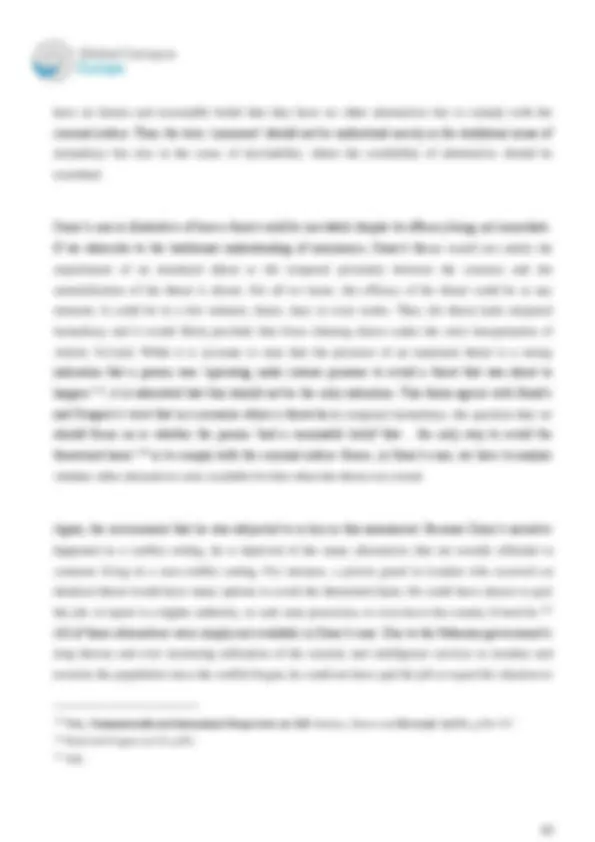
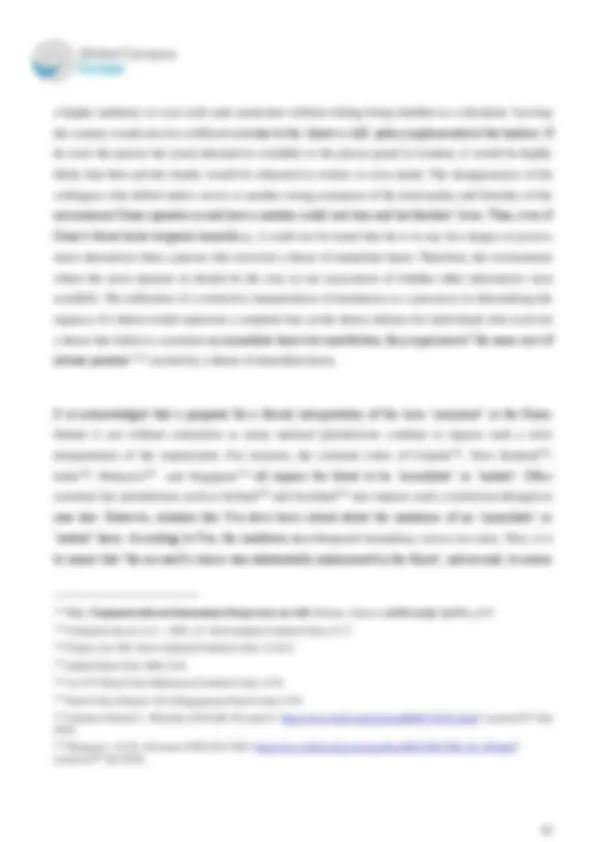

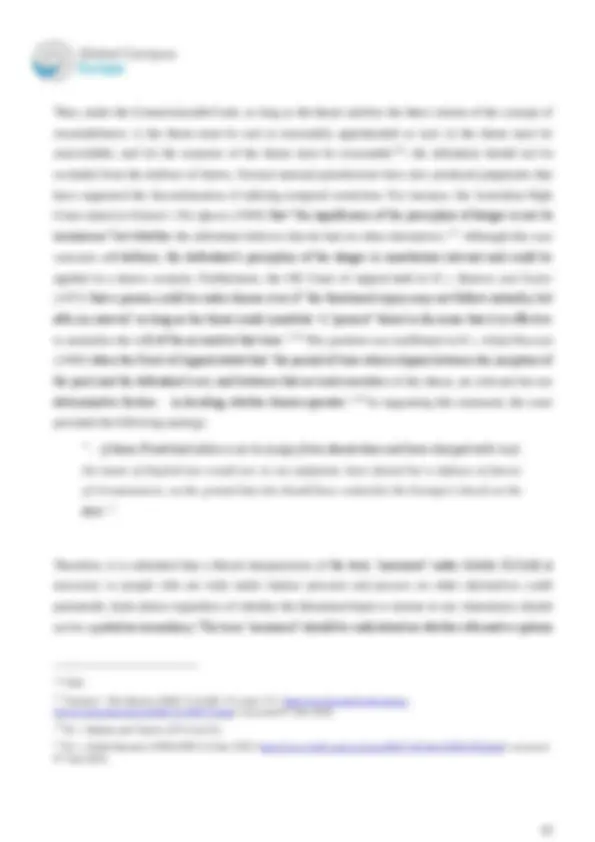
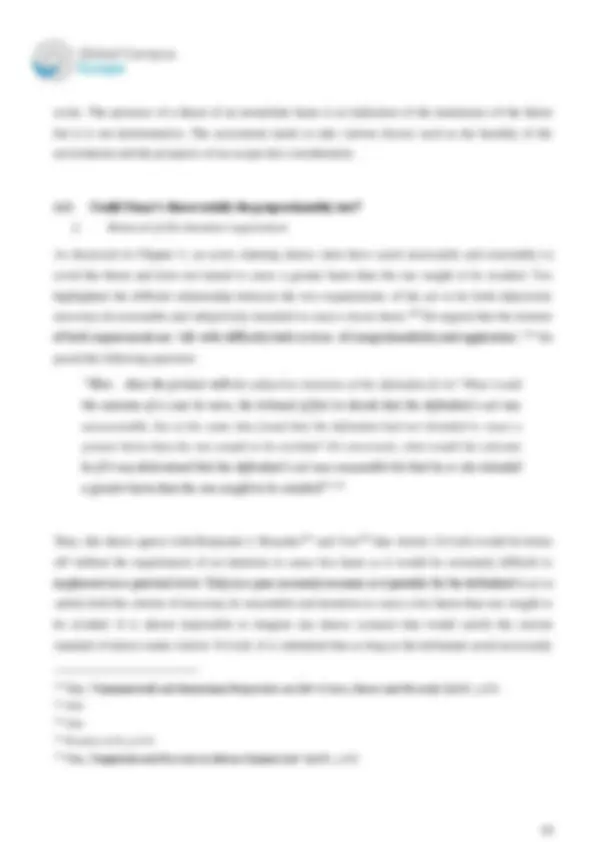
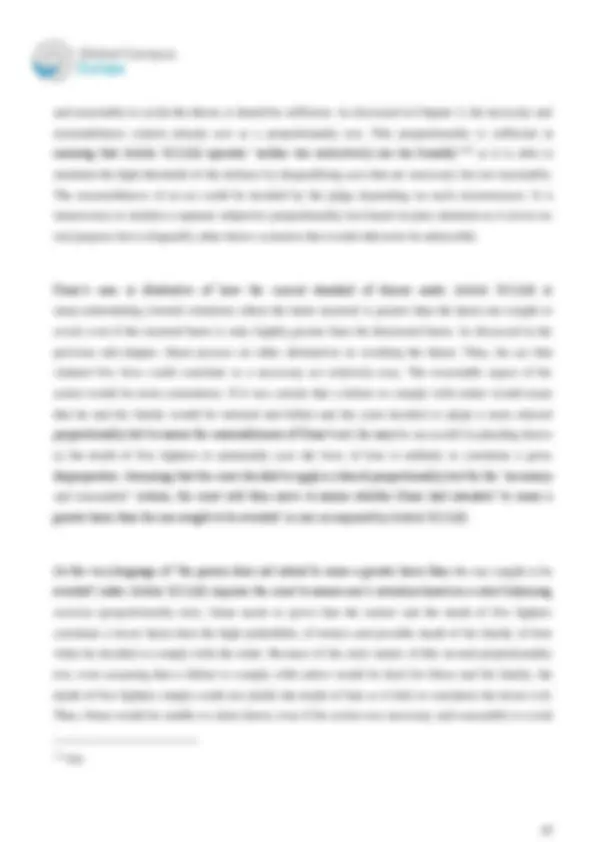
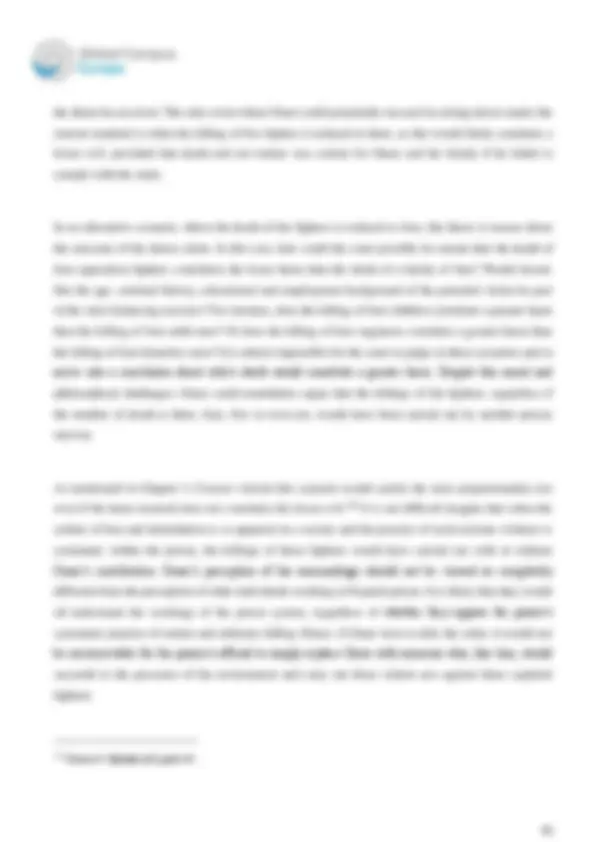
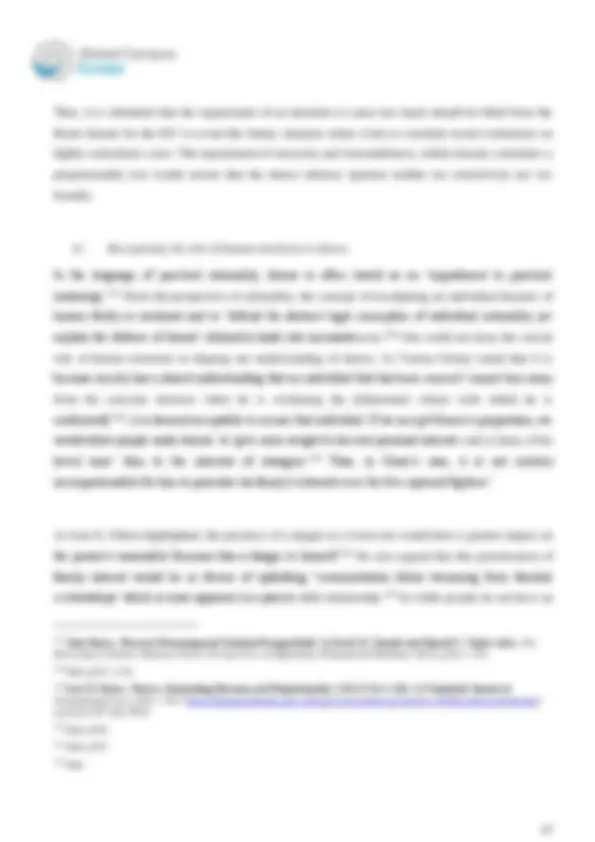
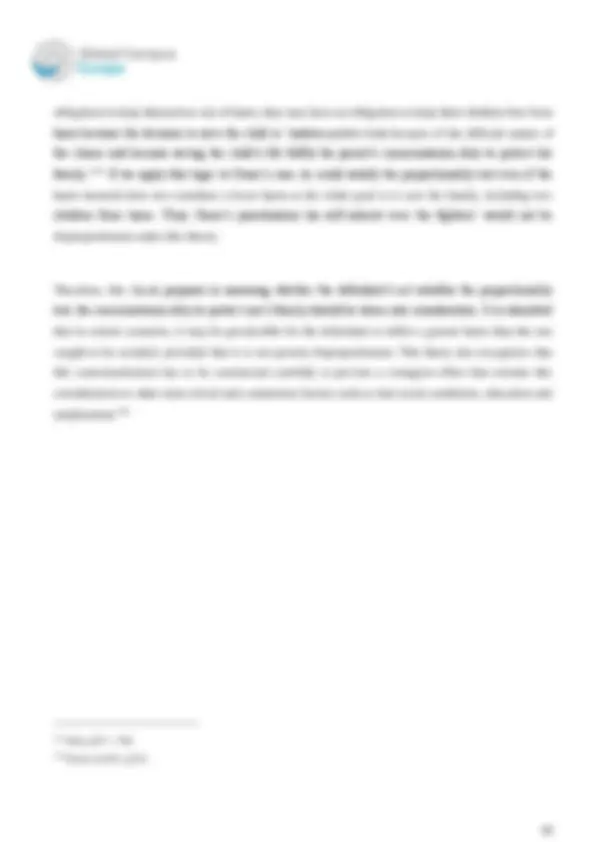
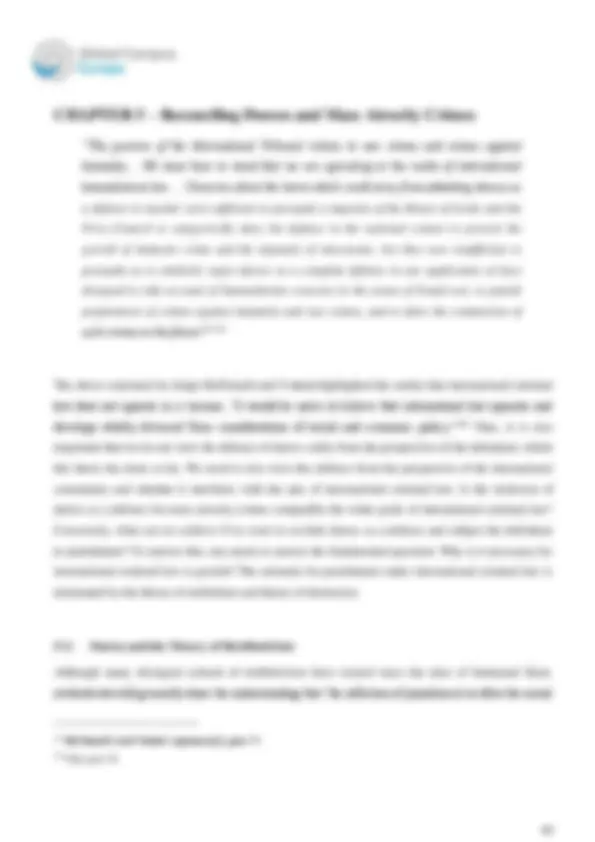

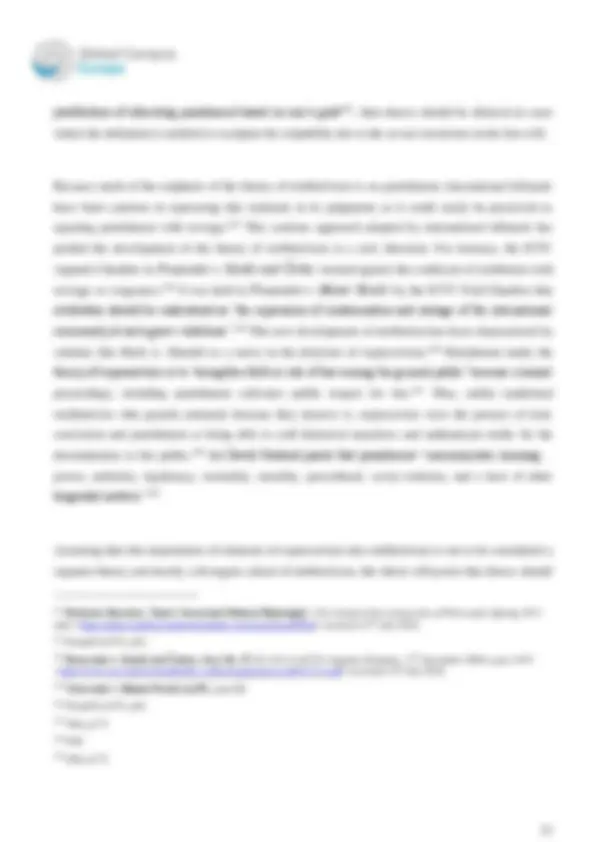
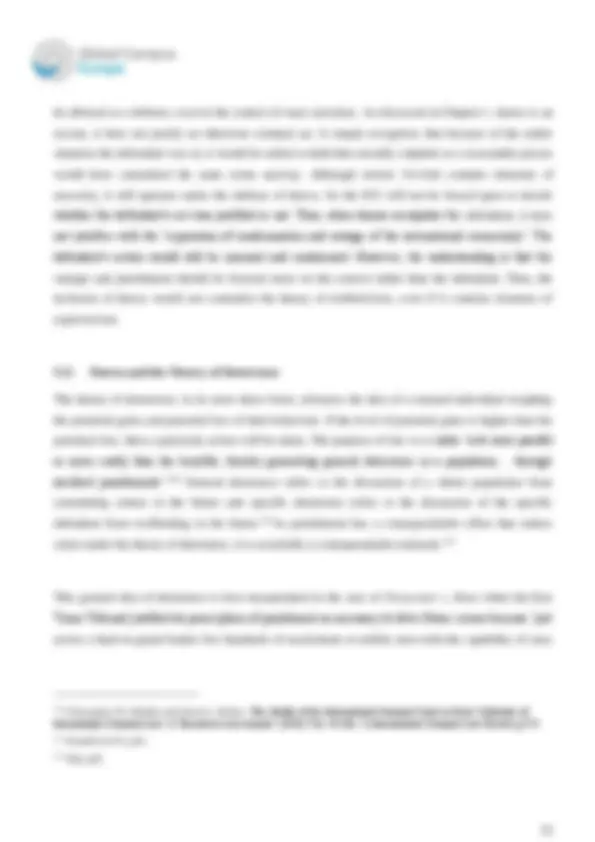
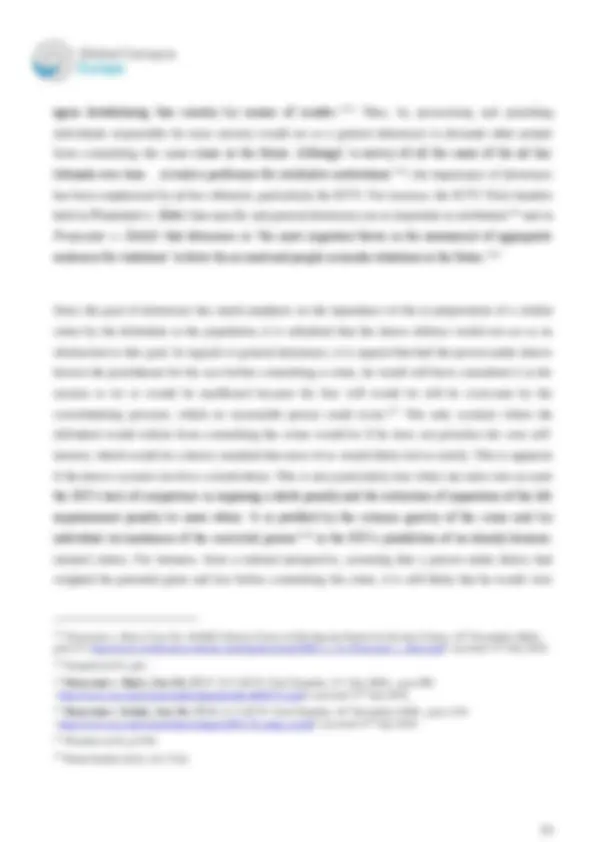
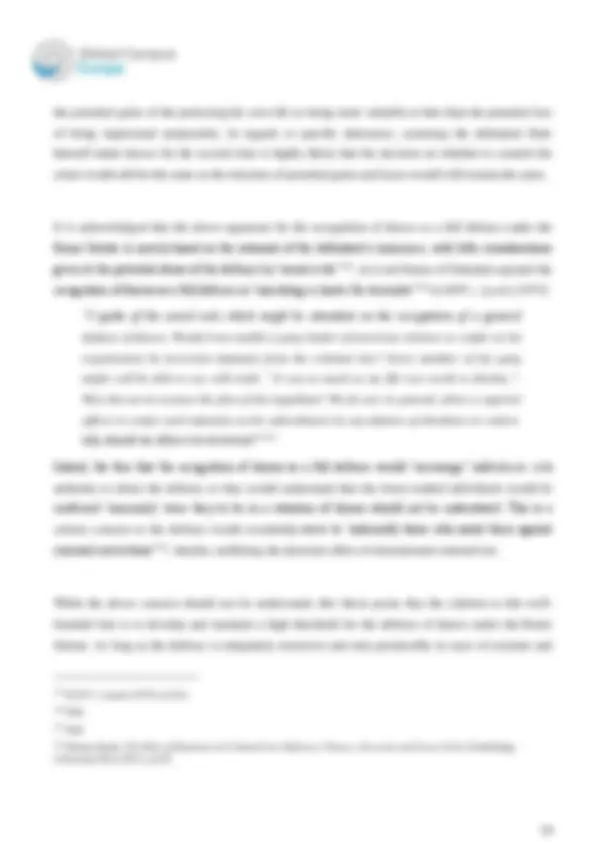
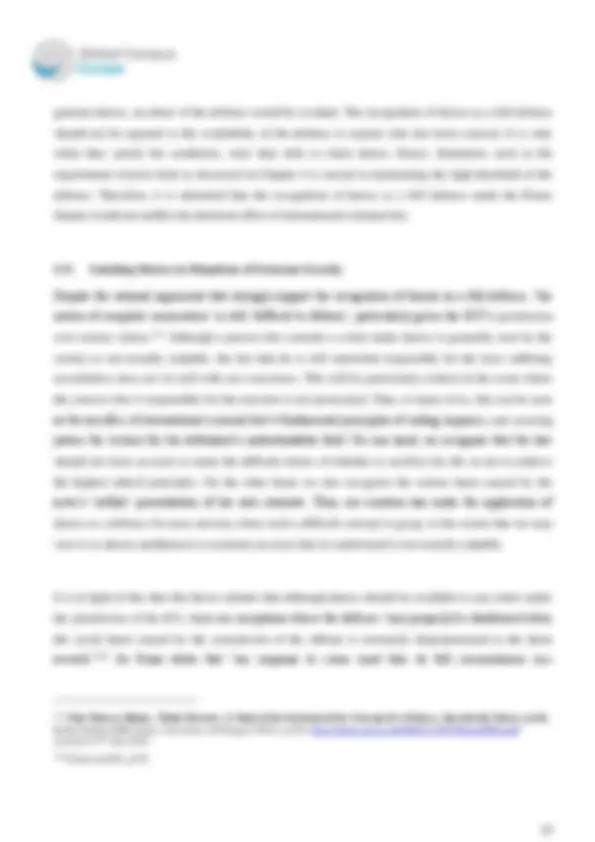

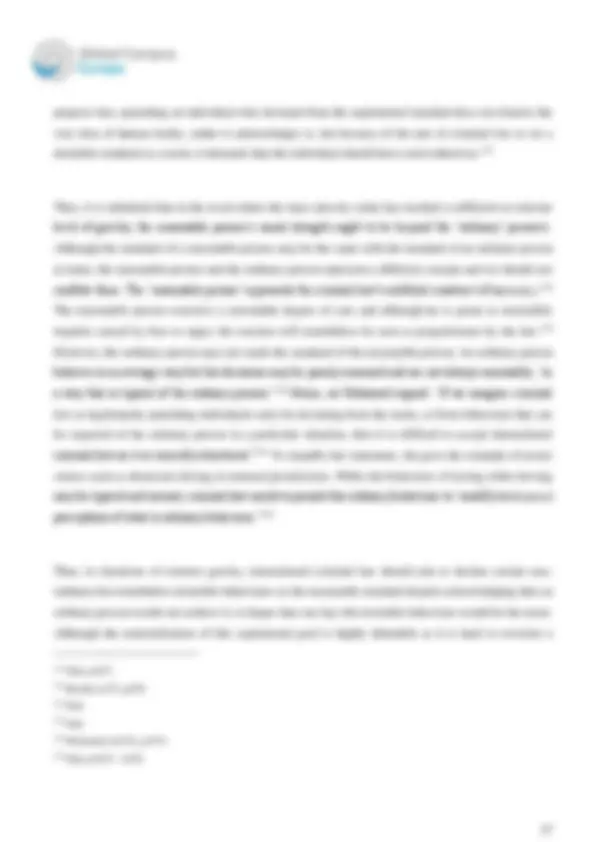
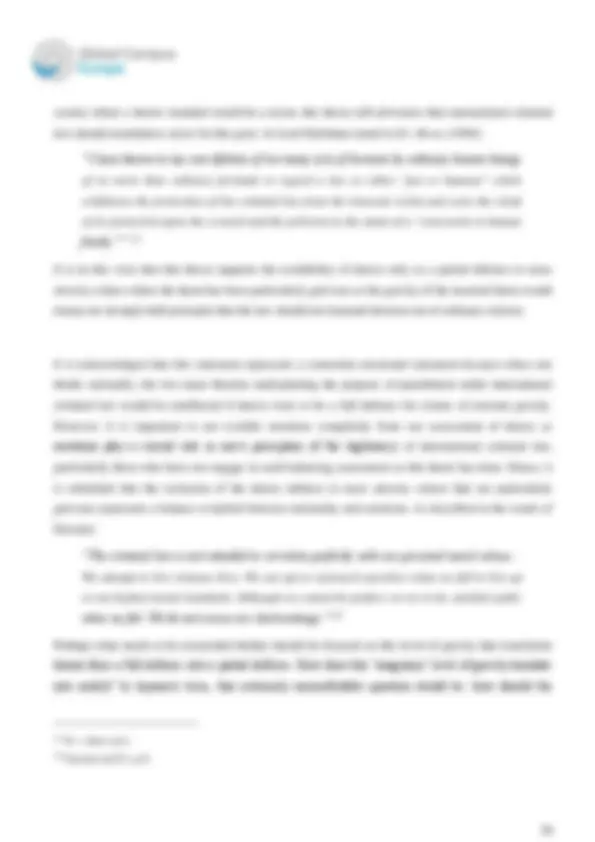

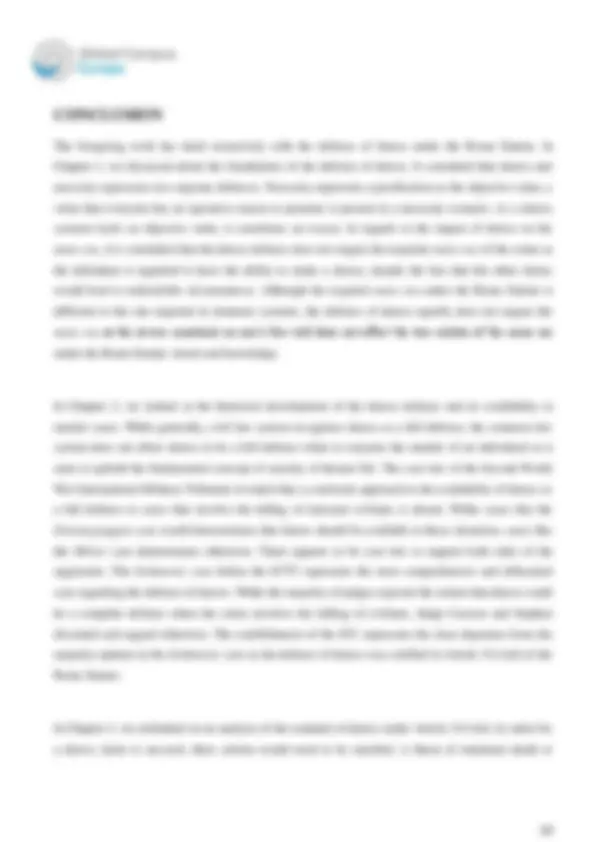
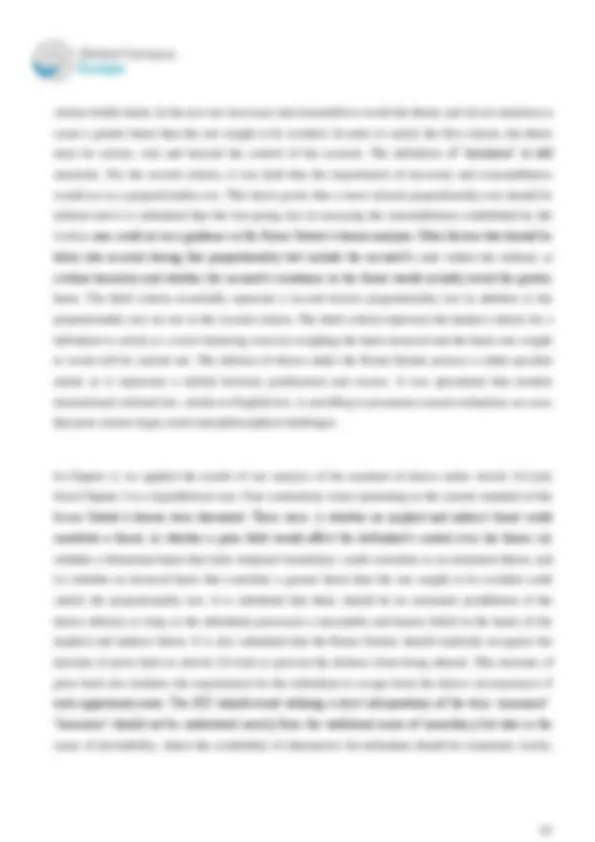
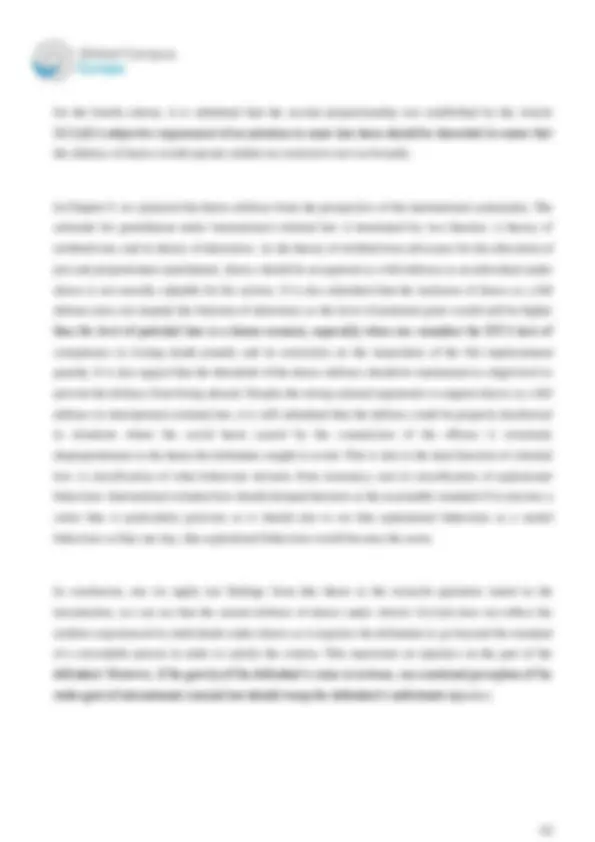











Study with the several resources on Docsity

Earn points by helping other students or get them with a premium plan


Prepare for your exams
Study with the several resources on Docsity

Earn points to download
Earn points by helping other students or get them with a premium plan
Community
Ask the community for help and clear up your study doubts
Discover the best universities in your country according to Docsity users
Free resources
Download our free guides on studying techniques, anxiety management strategies, and thesis advice from Docsity tutors
Raising the defence of duress for crimes against humanity and war crimes has always been contentious due to the tense relationship between law and morality.
Typology: Slides
1 / 71

This page cannot be seen from the preview
Don't miss anything!
































































ABSTRACT Raising the defence of duress for crimes against humanity and war crimes has always been contentious due to the tense relationship between law and morality. It poses serious philosophical, moral and legal challenges as it requires the judge to balance the accused life against the victims’. “How can a judge satisfy himself that the death of one person is the lesser evil that the death of another?” While the defence of duress is a well-established defence, substance of the defence under the Rome Statute is still rather elusive and ambiguous. This thesis aims to examine whether the current standard of duress under the Rome Statute reflects the realities of individuals experiencing duress. This thesis will analyse the criteria for a duress claim to succeed, the shortfalls of the current standard under the Rome Statute and balance the defendant’s justice with the wider goal of international criminal law.
INTRODUCTION Statement of the Problem In order to evade criminal liability, a defendant accused of a crime may wish to raise a defence, a feature that exists in both national and international law. Defences aim to either justify or excuse a criminal act that would otherwise be criminal and punishable. Thus, defences are, in Schabas’ words, ‘answers to a criminal charge’^1. Duress, being one of the few general defences is the interest of this thesis. Raising the defence of duress in the context of mass atrocity has always been contentious due to the tense relationship between law and morality. It poses serious philosophical, moral and legal challenges as it requires the judge to balance the accused life against the victims’. ‘How can a judge satisfy himself that the death of one person is the lesser evil that the death of another?’^2 With such complex balancing task, how does the defence operates within the realm of international criminal law that concerns the most heinous crimes known to mankind? The Charter of past international criminal tribunals like the International Criminal Tribunal for the former Yugoslavia (ICTY) and International Criminal Tribunal for Rwanda (ICRT) were silent on the availability of duress as a defence to the killings of innocent civilians. Till date, the most notable case regarding duress is the Erdemovic case, where the majority of the judges refused to admit duress as a defence to the killings of civilians to ‘assert an absolute moral postulate… for the implementation of international humanitarian law.’^3 However, with the establishment of the International Criminal Court (ICC), duress defied the Erdemovic judgment as the defence was codified within the Rome Statute. So unlike in the ICTY or ICTR era, duress could potentially be successfully raised for crimes against humanity and war crimes. (^1) William Schabas, An Introduction to the International Criminal Court (4th (^) edn, Cambridge University Press 2010), p238. (^2) Prosecutor v. Erdemovic, ‘Separate and Dissenting Opinion of Judge Cassese’, Case No.IT- 96 - 22 - S (Appeals Chamber, 7 th October 1997) [Cassese’s Opinion] para42 http://www.icty.org/x/cases/erdemovic/acjug/en/erd-adojcas971007e.pdf. (^3) Prosecutor v. Erdemovic, ‘Joint Separate Opinion of Judge McDonald and Judge Vohrah’, Case No.IT- 96 - 22 - S (Appeals Chamber 7 th^ October 1997 [McDonald’s and Vohrah’s Opinion] para http://www.icty.org/x/cases/erdemovic/acjug/en/erd-asojmcd971007e.pdf.
Thesis Structure This paper comprises five chapters. Chapter 1’s emphasis is on the definition of duress and necessity. The difference between duress and necessity will be discussed, followed by the classification duress and necessity as excuse and justification. The impact of the duress defence on the mens rea. This chapter ends with a section discussing the impact of duress on the mens rea in national courts and the ICC. Chapter 2 contains an analysis of the development of duress in international law before the codification of duress in the Rome Statute. The analysis will be focused on the (i) the civil law regime; (ii) the common law regime; (iii) the Second World War International Military Tribunals; (iv) the ICTY; and (v) the ICC. References will be made to the selected international and national case law of concerning duress. Chapter 3 contains the statutory analysis of the defence of duress under Article 31(d) of the Rome Statute. The Erdemovic case and the Second World War jurisprudence will be heavily utilised in this analysis. This chapter ends with a section on the classification of duress under Article 31(1)(d) of the Rome Statute, whether it represents a justification or an excuse or neither. Chapter 4 contains the application of the standard of duress before the ICC to a hypothetical case to examine the shortfalls and the contentious issues regarding the current standard of duress under Article 31(1)(d) of the Rome Statute. Four issues pertaining the duress defence will be discussed: 1) the recognition of an indirect and implied threat as a threat; 2) the requirement of prior fault; 3) the definition of imminent; and 4) the concept of proportionality. Chapter 5 represents a balancing exercise of the duress defence under the Rome Statute from the perspective of the defendant and the international community. The impact of the recognition of duress as a full defence on the purpose of punishment under international criminal law will be discussed. This chapter ends with a section discussing the limitation on the applicability of the duress defence to mass atrocity crimes of extreme gravity.
CHAPTER 1 – The Foundations of Duress 1.1) The Differences between Duress and Necessity The defence of duress has always been founded on criminal law’s concession to human frailty. The assumption is that one should not be held criminally liable for crimes committed “due to factors beyond his or her control such as… a threat from another that the accused or another person would be killed or grievously injured if he or she refused to commit a crime”.^4 Due to the overwhelming threat of violence, the defendant is deprived of the effective opportunity to make a choice on whether to commit the crime and is regarded to have acted involuntarily against his will. 5 Thus, it would be unfair to punish the coerced person as he is not morally blameworthy. The defence of necessity, on the other hand, resembles closely the defence of necessity. The main distinction between the two defences lies in the source of the threat.^6 “Duress arises from the wrongful threats or violence of another human being and necessity arises from any other objective dangers threatening the accused”.^7 While both defence of duress and necessity ‘compels’ the accused to commit a crime, the source of the threat for necessity originates from a non-human being. For duress, the threat originates from the intentional action of a human being. Thus, in a plea of necessity, the defendant would claim that because of the surrounding circumstances that he was in, he had no other alternatives but to commit the crime as “the evil of obeying the letter of the law is socially greater… than the evil of breaking it. In other words, the law has to be broken to achieve a greater good.”^8 1.2) Is Duress a Justification or Excuse? Defences can be broadly classed into two groups: justification and excuse. Justificatory defences “are not alterations of the statutory definition of the harm sought to be prevented or punished by an (^4) Kenneth J. Arenson, ‘The Paradox of Disallowing Duress as a Defence to Murder’ (2014) Vol. 78 (No. 1) The Journal of Criminal Law, p65. (^5) C.M.V Clarkson and H.M. Keating, Criminal Law: Text and Materials (4th (^) edn, Sweet & Maxwell 1998), p325. (^6) Clarkson and Keating (n5), p321–322. (^7) R v. Howe [1986] UKHL 4, p8 http://www.bailii.org/uk/cases/UKHL/1986/4.html accessed 30th (^) May 2018. (^8) Glanville Williams, Textbook of Criminal Law (1st (^) edn, Stevens & Sons 1978), p553.
‘negates a conclusion of guilt even though the necessary mens rea was present’.^19 This was highlighted by the Canadian Supreme Court in R v Ruzic [2001] that ‘although moral involuntariness does not negate the actus reus or mens rea of an offence’, it deserves protection as ‘it is a principle of fundamental justice that only voluntary conduct – behaviour that is a product of a free will and controlled body… should attract the penalty and stigma of criminal liability’^20. Thus, a person acting under duress are excused because of the wrongfulness of the threat, not because they acted involuntarily.^21 The actor would be regarded as to have the ability to make a choice, regardless of whether the other choice leads to undesirable consequences such as one’s own death or serious injury. 1.4) Mens Rea Under the Rome Statute. The doctrine of mens rea pertinent to the ICC can be found in Article 30 of the Rome Statute. The codified mens rea is only applicable to crimes under the ICC’s jurisdiction and has no binding effect on other international tribunals.^22 The default requirement for mens rea under Article 30 encompasses two separate entities: intent and knowledge.^23 An individual is deemed to possess the intent if he ‘means to engage in the conduct’^24 or ‘means to cause that consequence or is aware that it will occur in the ordinary course of events.’^25 This means that unintentional conduct (e.g. reflex behaviour & accidents) and ‘mere anticipation of a possibility that illegal conduct may cause prohibited consequences’ would not satisfy the threshold of mens rea under Article 30(2)(b).^26 In relation to knowledge, it is required that the individual is aware ‘that a circumstance exists or a consequence will occur in the ordinary course of events.’^27 The knowledge requirement would have to be accompanied by the contextual (^19) United States v. Bailey (1980) 444 U.S. 394 https://supreme.justia.com/cases/federal/us/444/394/case.html accessed 1st June 2018. (^20) R v. Ruzic (2001) 3 LRC 703, p688–689 https://scc-csc.lexum.com/scc-csc/scc-csc/en/1861/1/document.do accessed 1 st^ June 2018. (^21) R v Palazoff (1986) 43 SASR 99. (^22) Iryna Machuk, The Fundamental Concept of Crime in International Criminal Law: A Comparative Law Analysis (Springer 2014), p125. (^23) Ibid, p127. (^24) Rome Statute of the International Criminal Court (adopted 17th (^) July 1998, entered into force 1st (^) July 2002) 2187 UNTS 90 [Rome Statute], Art 30(2)(a). (^25) Ibid, Art 30(2)(b). (^26) Machuk (n22), p128. (^27) Rome Statute (n24), Art 30(3).
elements of the crime.^28 For instance, a crime against humanity requires the additional mental element of a knowledge that the conduct was part of ‘a widespread and systematic attack directed against a civilian population.’^29 Thus, the defence of duress, similar in a national context, does not negate the mens rea under the Rome Statute as acting against one’s will does not affect the individual’s intention and knowledge of his act. (^28) Machuk (n22), p133. (^29) Rome Statute (n24), Art 7(1).
It was confirmed by the majority of the House of Lords in R v. Howe [1986] that the English criminal law does not ‘allow duress as a defence to murder’^35. Although some American state jurisdictions have accepted duress as a defence to murder^36 , generally, the common law system does not recognise duress as a complete defence for murder. This exclusion of the defence to murder can be traced to Lord Hale’s statement from his Pleas of the Crown in the 19th^ century, where he stated that: “If a man be desperately assaulted, and in peril of death, and cannot otherwise escape, unless to satisfy his assailant's fury he will kill an innocent person then present, the fear and actual force will not acquit him of the crime and punishment of murder, if he commits the fact for he ought rather to die himself, than kill an innocent.”^37 Hale’s position was reiterated by William Blackstone in his Commentaries when he stated that ‘escaping death… by killing an innocent person… shall not acquit him of murder; for he ought rather to die himself than escape by the murder of innocent’^38. The rationale for this exclusion is ‘based upon the special sanctity that the law attaches to human life and which denies to a man the right to take an innocent life even at the price of his own or another’s life.’^39 Thus, unlike in civil law jurisdictions, the common law’s position is that the sanctity of human life is of utmost importance and it trumps any other considerations, such as the defendant’s free will.^40 2.3) Second World War International Military Tribunal (^35) R v. Howe [1986] (n7), p18. (^36) M. Sornarajah, ‘Duress and Murder in Commonwealth Criminal Law’ (1981) Vol. 30 (No. 3) The International and Comparative Law Quaterly 660-681, p https://www.jstor.org/stable/pdf/759291.pdf?refreqid=excelsior%3Abf7d6275d334816ae8db415212a79bd8 accessed 8th June 2018. (^37) Rosa Ehrenreich Brooks, ‘Law in the Heart of Darkness: Atrocity & Duress’ (2003) Vol. 43 Virginia Journal of International Law, p878–879 https://scholarship.law.georgetown.edu/cgi/viewcontent.cgi?article=2141&context=facpub accessed 10th^ June 2018. (^38) Russell Shankland, ‘Duress and the Underlying Felony’ (2009) Vol. 99 (No. 4) Journal of Criminal Law and Criminology, p1237 https://scholarlycommons.law.northwestern.edu/cgi/viewcontent.cgi?article=7342&context=jclc accessed 10th^ June 2018. (^39) R v Howe [1986] (n7), p18. (^40) Sornarajah (n36), p661–662.
The Second World War International Military Tribunals (IMT) case law did not give rise to a general consensus on the applicability of duress to murder. It is important to note that duress is often termed ‘necessity’ or ‘coercion’ in the IMT case law and often raised in conjunction with superior orders, though duress has little necessary connection with superior order. Although Article 8 of the Charter of the IMT prohibits the application of the defence of superior orders as a complete defence, the United States Military Tribunal stated in the Einsatzgruppen case that ‘the true test… is not the existence of the order, but whether moral choice was in fact possible.’^41 Because the law does not require an innocent man to sacrifice his life in order to avoid a crime which he condemns, if the defendant was coerced into executing an unlawful order, it constitutes duress.^42 However, one needs to prove that (i) the defendant has acted under coercion; and (ii) the defendant has made attempts to evade the order every time an opportunity arises.^43 The general rule regarding duress is best encapsulated by the following statement in the Einsatzgruppen case: “Let it be said at once that there is no law which requires that an innocent man must forfeit his life or suffer serious harm in order to avoid committing a crime which he condemns. The threat, however, must be imminent, real and inevitable. No court will punish a man who, with a loaded pistol at his head, is compelled to pull a lethal lever.”^44 The Flick^45 , I.G. Farben^46 and Krupp^47 Trials represent the three ‘industrialist trials’ where the accused claimed that they were under duress when they employed forced labour, insisting that the dire consequences from not reaching the production quotas set by the Third Reich left them with no other choice but to employ forced labour. Although not all three cases resulted in the successful plea of (^41) United States v. Ohlendorf, ‘The Einsatzgruppen Case’ Military Tribunal Case No. 9 (8th (^) April 1948), p471 < https://www.legal-tools.org/doc/74e839/pdf/> accessed 11th^ June 2018. (^42) Ibid, p480. (^43) Ibid, p480–481. (^44) Ibid, p480. (^45) Trial of Friedich Flick and Five Others, ‘Trials of War Criminals Before the Nuernberg Military Tribunals under Control Council Law No. 10’ (U.S. Government Printing Office 1952) [Flick Trial], p1200– 1202 https://www.loc.gov/rr/frd/Military_Law/pdf/NT_war-criminals_Vol-VI.pdf accessed 12th^ June 2018. (^46) Trial of Carl Krauch and Twenty-two Others, ‘Law Reports of Trials of War Criminals’ (United Nations War Crimes Commission 1949) [I.G. Farben Trial], p54–57 https://www.loc.gov/rr/frd/Military_Law/pdf/Law-Reports_Vol-10.pdf accessed 12th^ June 2018. (^47) Trial of Alfried Felix Alwyn Krupp von Bohlen und Halbach and Eleven Others, Ibid, [Krupp Trial], p146–150.
no doubt on the authorities that compulsion is a defence when the crime is not of a heinous character. But the killing of an innocent person can never be justified.”^51 The Fëurstein case too followed the same logic and held that duress is unavailable for an accused charged with the killings of civilians.^52 Hence, there appears to be no consistent rule to the controversy over the applicability of duress to the murder of innocent civilians as there are case law that supports both side of the arguments. Discussion about duress that appeared in the IMT judgments also often remain merely a dictum^53 and tribunals tend to employ their national law^54 , most evident in the Hölzer case, which undoubtedly would end up in different outcomes of applicability of duress. 2.4) The International Criminal Tribunal for the Former Yugoslavia (ICTY) Perhaps the most influential case regarding duress in the context of mass atrocity is the Erdemovic case. Background Drazen Erdemovic, a self-identified Bosnian Croat, was born in 1971 in Bosnia and Herzegovina in the Socialist Federative Republic of Yugoslavia.^55 He was raised in a ‘multi-ethnic surroundings in a non- nationalistic environment’ and ‘had friends from all groups – Serbs, Croats, Muslims’^56. He opposed the Bosnian war and had previously ignored the summons to join the army of Bosnia and Herzegovina in May or July 1992.^57 In November 1993, he left the Croatian Defence Council (HVO) as he believed his position there was insecure for he ‘had been arrested and beaten by HVO soldiers for having helped (^51) Prosecutor v. Drazen Erdemovic, ‘Separate and Dissenting Opinion of Judge Li’, Case No. IT- 96 - 22 - A (Appeals Chamber 7 th^ October 1997) [Li’s Dissenting Opinion), para7 <http://www.icty.org/x/cases/erdemovic/acjug/en/erd- asojli971007e.pdf> accessed 13th^ June 2018. (^52) Judge Cassese’s opinion (n2), para25. (^53) Ibid. (^54) Ibid, para26. (^55) The Prosecutor v. Drazen Erdemovic, ‘Sentencing Judgment’, IT- 96 - 22 - T (29th (^) November 1996) [Initial Trial Chamber Decision], para102 http://www.icty.org/x/cases/erdemovic/tjug/en/erd-tsj961129e.pdf accessed 7th^ June 2018. (^56) Ibid, para105. (^57) Ibid, para79.
Serbian women and children return to their territory’^58. He attempted to escape the war and the Balkan region altogether for Switzerland, however, he failed to obtain the identity papers.^59 Out of financial desperation and other personal reasons, he joined the Bosnian Serb Army in April 1994, and specifically chose the more ethnically diverse, non-combative 10th^ Sabotage Unit.^60 On the 16th^ July 1995, Erdemovic and seven other members of his unit were ordered to Branjevo farm at Pillica without any knowledge of the mission. It was only when they arrived on-site, were they ordered to ‘massacre hundreds of Muslims’^61. Erdemovic refused to comply at first but he surrendered to the orders after being threatened with death by the commander.^62 In Erdemovic’s own words: “Your Honour, I had to do this. If I had refused, I would have been killed together with the victims. When I refused, they told me: ‘If you’re sorry for them, stand up, line up with them and we will kill you too.’ I am not sorry for myself but for my family, my wife and son who then had nine months, and I could not refuse because then they would have killed me.”^63 Erdemovic also asserted that prior to this, he had witnessed the killing of someone who refused to obey orders.^64 Of the approximately 1,200 Muslims who were executed that day by the 10th^ Sabotage Unit^65 , it was estimated that Erdemovic was responsible for the killing of between 10 and 100.^66 Approximately a month after the incident, he confided in a journalist and was arrested by the State Security Services of the Republic of Serbia.^67 On the 30th^ March 1996, Erdemovic arrived in The Hague and confessed to the Office of the Prosecutor of the ICTY, where he ‘continuously reiterated his loathing of war and nationalism and how deeply he regretted his criminal act’^68. (^58) Ibid. (^59) Ibid. (^60) Ibid. (^61) Ibid, para80. (^62) Ibid. (^63) Ibid, para10. (^64) Ibid. (^65) Ibid, para77. (^66) Ibid, para85. (^67) Ibid, para81. (^68) Ibid.
the weak and vulnerable.^78 ‘Without engaging in a complex and tortuous investigation into the relationship between law and morality, they held that if national common law refuses to admit duress as a complete defence when it concerns the murder of a single innocent life, then it would be unacceptable for international law to admit duress as a complete defence when it concerns ‘the slaughter of innocent human beings on a large scale.’^79 Thus, their refusal to admit the duress defence was to ‘assert an absolute moral postulate… for the implementation of international humanitarian law.’^80 Judge Li wrote a separate opinion supporting Judges McDonald and Vohrah on the admissibility of duress.^81 Nonetheless, Judges Cassese and Stephen dissented, arguing that duress should be admitted as a complete defence to a charge of crimes against humanity and war crimes.^82 Judge Cassese argued that as there was no specific international rule on duress, the defence should prevail based on law and logic as ‘if no exception to a general rule be proved, then the general rule prevails.’^83 Cassese’s also disagreed with the majority of the judges’ investigation of ‘practical policy considerations’ that, in his opinion, has been ‘substantially based on English law.’^84 Cassese contended that the examination has been ‘extraneous to the task’ of the Tribunal as the Tribunal was called upon to apply international law’^85. Thus, the Tribunal should avoid ‘relying exclusively on notions, policy considerations or the philosophical underpinnings of common-law countries, while disregarding… other systems of law.’^86 He stated that: (^78) Ibid. (^79) Ibid. (^80) Ibid, para83. (^81) Judge Li’s Opinion (n51) (^82) Cassese’s Dissenting Opinion (n49), para 50; Prosecutor v. Drazen Erdemovic, ‘Separate and Dissenting Opinion of Judge Stephen’, Case No. IT- 96 - 22 - A (Appeals Chamber 7 th^ October 1997), para 66 http://www.icty.org/x/cases/erdemovic/acjug/en/erd-asojste971007e.pdf accessed 13th^ June 2018. (^83) Cassese’s Opinion (n2), para11(i). (^84) Ibid, para11(ii). (^85) Ibid. (^86) Ibid.
“Law is based on what society can reasonably expect of its members. It should not set intractable standards of behaviour which require mankind to perform acts of martyrdom, and brand as criminal any behaviour falling below those standards”^87 According to Cassese, the four requirements that need to be satisfied to raise the defence of duress that are based on international case law is as follow: (i) “the act charged was done under an immediate threat of severe and irreparable harm to life or limb; (ii) there was no adequate means of averting such evil; (iii) the crime committed was not disproportionate to the evil threatened (this would, for example, occur in case of killing in order to avert an assault). In other words, in order not to be disproportionate, the crime committed under duress must be, on balance, the lesser of two evils; (iv) the situation leading to duress must not have been voluntarily brought about by the person coerced.”^88 Although Cassese’s four-part-test did not prevail in the Erdemovic case, it did heavily influence the drafters of the Rome Statute and the Rome Statute’s duress contains many elements of Cassese’s four requirements. 2.5) The International Criminal Court The Rome Statute represents the first comprehensive codification of international criminal law. The will to codify international criminal law as much as possible to the Rome Statute was clear during the Rome Conference as States were unwilling to give the judges as much liberty as in ICTY Statute.^89 However, in the beginning, the draft statute for the ICC did not contain any provisions that include (^87) Ibid, para47. (^88) Ibid, para 16. (^89) Jeremie Gilbert, ‘Justice not revenge: the international criminal court and the ‘grounds to exclude criminal responsibility’: defences or negation of criminality’ (2006) Vol. 10 (Issue 2) The International Journal of Human Rights, p https://eprints.mdx.ac.uk/4268/1/Gilbert-Justice_not_revenge.pdf accessed 29th^ June 2018.